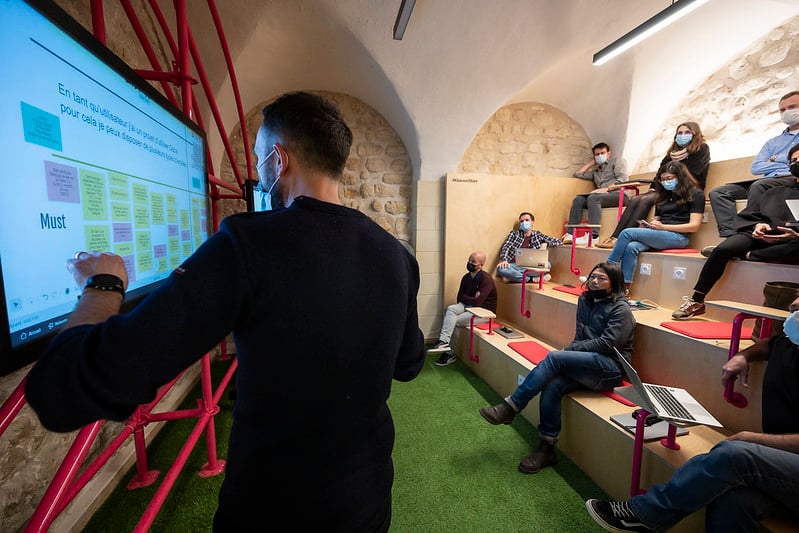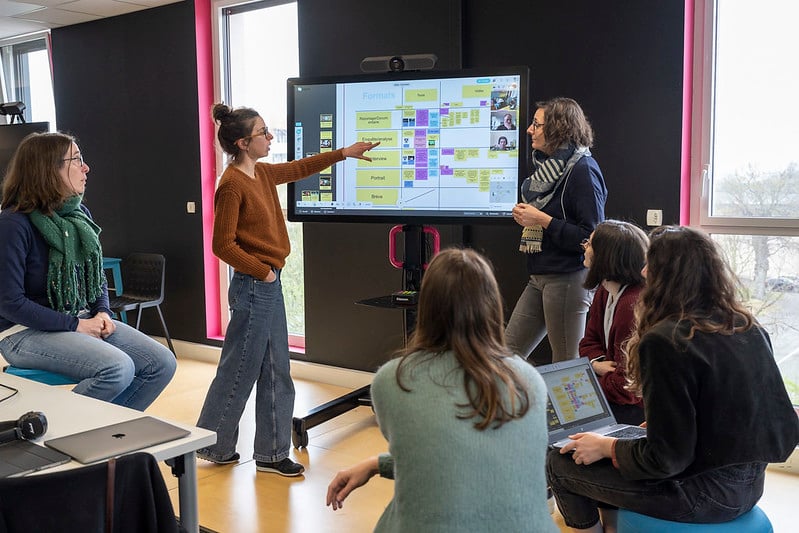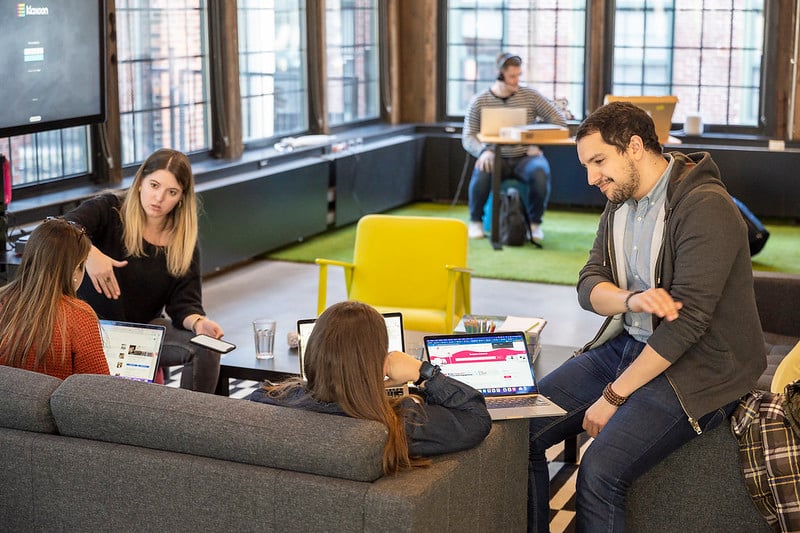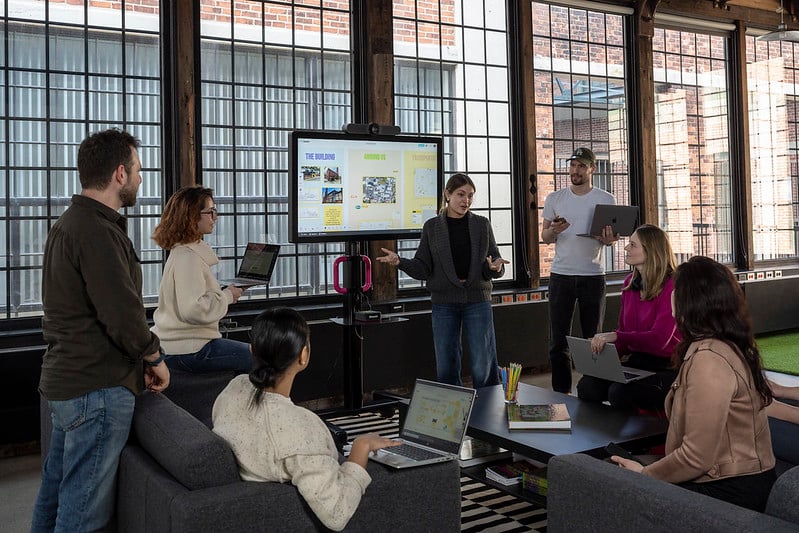Workshop facilitation: all you need to know to get started
Published on February 14, 2025
Workshop facilitation: all you need to know to get started
Often thought of as just a way of running workshops, facilitation is a much more sophisticated tool than that. More importantly, you don’t have to be trained and know all every single facilitation technique. While this role is essential to run your workshops properly, there are numerous tools available that mean everyone can do it.
What do we mean when we talk about workshop facilitation? To sum up in three points, facilitation is about:
It's a means and not an end. Facilitation is one of the ways to get the best ideas out of a group. It helps unlock situations, encourage participation and get everyone engaged.


Easily turn any place into a workshop room to engage the participants.
Regularly facilitating workshops can also be an excellent form of professional development. Playing an active role in bringing team projects to fruition is a way of promoting self-esteem and confidence. The more you practice, the more those feelings will increase. It's a great way to boost your motivation and commitment on a daily basis. There is more than an only answer to the question : how to organize a workshop?
By becoming a workshop facilitator yourself, you will have some objectives to focus on, mainly to help your group reach their own goals. To be more specific on yours, you should aim for:
In short, it’s a demanding but highly rewarding role. And getting started is simple: just put a few rules into practice – and bend a few more! Here is our advice.
To continue exploring the concept of facilitation and to help you practice it, let’s step aside into the world of storytelling.
Have you heard of the hero's journey? It‘s a storytelling concept, which describes the stages in the hero or heroine’s initiation or quest: from their often modest beginnings to fulfilling their destiny. One of the recurring stages of the story is the idea that to succeed, a hero needs a guide. For example, in the Star Wars saga, Luke Skywalker gradually changes from being a farmer to becoming a powerful warrior with the help of his master Obi-Wan Kenobi. Clearly, he becomes a hero by following his mentor’s example. These are two distinct but complementary roles.
And guess what? You are the guide. You must guide your heroines and heroes to help them achieve their goals. So in real terms, how do you do that?
Whether you want to get as many people as possible involved or boost your teams’ performance, preparation is the key to success.
Your preparation should focus on the goals that the team has to achieve. And obviously, that means the team, and not only you! This is one of the specific features of this task: your success is dependent on the group. And to measure it, use this check-list.
The first criterion is clear. The second and third are more complicated to put into action and are dependent on your preparation and how you facilitate. Put simply, they represent content and form respectively.
For content, you have to decide which topics to address, how to deal with them, and of course, how to explain the objectives of the workshop and the resultant action plan.
With respect to form, ask yourself what your agenda is, how to articulate it, what activities are proposed, in what forms, and how much time for each one. To take notes and make an instant impact, use shared visual tools such as a whiteboard.
Make sure you think about time management. Give clear time frames to be respected for all the modules to be explored, even break times: “The workshop will last this long, we will spend x minutes on this task.” Set everyone at the same pace!
Finally, don’t forget the people attending remotely. Use video conferencing so everyone can follow the discussion. And for you, this is a way to see everyone attending and pay attention to their non-verbal communication. A veritable mine of information.
Florence Vallet is a collective intelligence facilitator. Workshop facilitation is her life and for her, preparation is essential. "In the process of preparing for a workshop, you have to discuss with stakeholders to decide on the issues, the objectives and who should take part. [...] The fluidity that can be achieved during the actual workshop is the result of painstaking work behind the scenes.
The more meticulous your preparation, the more likely your workshop will be to deliver the right results. Basically, you won't do the same tasks to prepare an agile workshop or a mind mapping workshop.


On site or remotely, teamwork efficiency is improved all the same.
Facilitation is first and foremost about letting everyone have their say and encouraging participation. It’s vital to communicate, to generate good ideas, and compare points of view. And this is what it's all about when you facilitate a workshop. To boost everyone's participation, you can follow these guidelines.
First, create a climate of trust. To do this, there's nothing like an icebreaker! Like a warm-up before a race, this exercise puts everyone at ease in minutes. Fun and friendly, icebreakers are a great way to get to know your audience and to identify personality types. For example, use sweet treats to find out who is hiding behind each anecdote.
Then, take your prepared items, your plan, objectives, materials – and share them with the attendees. Gary Shapiro, President and CEO of the Consumer Technology Association (CTA), when recently questioned on the topic of engagement in workshops, made no secret of it: "Make them understand why. Why you are here, why it is important and what you’re doing." This step is crucial for everyone's success.
Take the opportunity to question your audience. Ask them if everything is clear, what do they want to happen, what are their objectives, is the workshop plan okay with them?
Likewise, make sure you take the time to answer any questions you may be asked. For attendees to work together effectively, they must be on the same page with respect to objectives, expected outcomes and how to achieve them.
During the workshop, create some movement. You can switch between group sessions and individual sessions. You can end a workshop with a quiz or a survey, so everyone can check how much information they've retained and take a breather. Once again, ask questions, interrogate them, and make sure they get involved. A workshop is a living thing, so breathe life into it!
If you are starting out in facilitation, a very easy way to bring the workshop to life is to use several proven methods of collaboration. For example, for brainstorming sessions, use the team relay technique so everyone can bounce ideas off each other, in turn. This is a very good gateway to the world of collective intelligence. To follow-up on project management, why not try the Rose, Thorn, Bud method, to uncover what worked well (Rose), what didn’t work (Thorn) and what remains to be explored (Bud).
There are dozens like this. These methods are there to help you effectively support your teams, so make sure you try them out, to find the best ones.
The success of your workshops does not just rest on your shoulders. Build on the strengths of those present, because they are what will make them a success. Trust them and give them more autonomy.
All these different tips are here to help you take your first steps into facilitation. But bear in mind that all templates and methods evolve constantly, because each group is different and each workshop is different. You are there to fine-tune, to listen, to reframe suggestions.
For example, if you planned for a five-step action plan to be created at the end of the workshop, focus on the two or three essential steps that cannot be overlooked. If the teams’ timing goes awry, your job will be not to keep them at all costs, but to make sure they choose the better of these few must-haves. To be clear, leave some room for improvisation. Because improvisation is about building on the ideas of others. Which is a little bit like facilitation, too.


You can both set a clear agenda for your workshop and leave some time for everyone to unleash their creativity.
To find out if your facilitation was successful, ask attendees what they thought about it. Feedback is what enables you to turn intuition into certainty. Your facilitation will keep on improving, workshop after workshop. Review the different stages of your workshops with your audience: what they have liked, what they have liked less, what needs to be improved, what needs to be changed.
All aspects of the feedback are important, provided it is constructive and kind. Based on this feedback, you can then do your own self-assessment and focus your progress on specific points.
Maintaining a feedback culture is a must in the role of a facilitator. The most experienced facilitators make it one of the cornerstones of their success. This is the case with Jérôme Rajkovic, agile coach at Inetum and workshop facilitator, who uses the Scaled Agile Framework (SAFe): "During the workshop, we review each step, to make sure everything has been understood and that the workshop is heading in the right direction. [...] At the end, the whole workshop is assessed using the ROTI method. Everything can be challenged and that is what makes us more effective."
Also remember to ask questions again, a short while after the workshop. After the event, the workshop attendees will almost certainly see things differently, which can also be relevant.


Make sure everyone always has the opportunity to share their feedback with the rest of the participants.
Unlock your teamwork potential